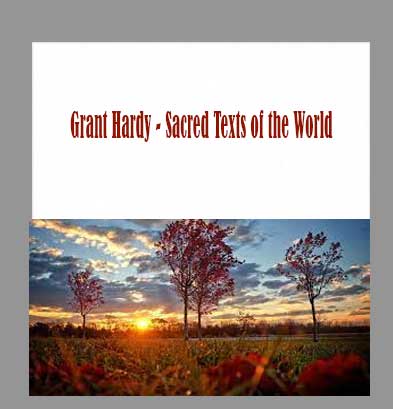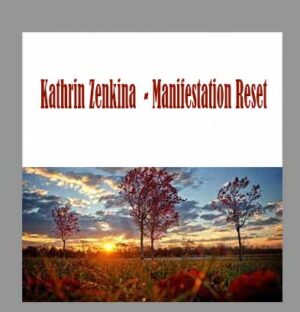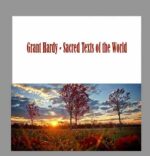Description
Grant Hardy – Sacred Texts of the World download, Grant Hardy – Sacred Texts of the World review, Grant Hardy – Sacred Texts of the World free
Grant Hardy – Sacred Texts of the World
Sacred Texts of the World
Delve deeply into the sacred writings that have shaped the identities, beliefs, and actions of large segments of humanity-texts that still exert influence in today’s world.
LECTURE (36)
01:Reading Other People’s Scriptures
Throughout history, the world’s sacred texts have held profound significance for the cultures that produced them. Consider five key reasons for the importance of studying them, from their accessibility and centrality to their cultures of origin to the wisdom they contain and the enlarged perspective they offer on our own traditions….
02:Hinduism and the Vedas
Grasp the nature and roles of sacred writings within Hinduism, as contrasted with the Judeo-Christian tradition. Learn about the structure of the Vedas, comprising collections of hymns and commentaries, and their meaning and function in Hindu ritual. Read compelling excerpts from the Vedas, and learn how Western religious scholars have approached them….
03:What Is Heard-Upanishads
The Upanishads constitute the philosophical or wisdom texts of the Hindu Vedas. Study the composition of the Brihadaranyaka and Chandogya Upanishads, containing spiritual arguments and dialogues revealing the underlying unity of brahman (ultimate reality) and atman (the self or soul). Trace the Upanishads’ influence on Westerners….
04:What Is Remembered-Epics
A second body of Hindu sacred writings encompasses literature, texts that explore the nature of dharma, the eternal laws and principles that give meaning and shape to life. Here, discover two great Indian epics: the Ramayana, a mythic narrative of kingship; and the Mahabharata, a complex story of familial bonds and discord….
05:Laws of Manu and Bhagavad Gita
Learn about the huge canon of Hindu sutras, shastras, Puranas, and Tantra. Delve into two highly influential texts: the Laws of Manu, outlining rules, customs and guidelines for living for the four Indian castes; and the beloved Bhagavad Gita, which speaks to matters of spiritual insight, social obligation, and worldly success….
06:Related Traditions-Sikh Scriptures
Trace the evolution of the Sikh religion, and the lineage of gurus that produced the faith’s sacred text, the Adi Granth. Study the composition of the Adi Granth; sample its beautiful hymns, poems, and prayers; and learn how the book is treated by Sikhs as a living guru….
07:Judaism-People of the Book
In approaching the sacred texts of Judaism, learn the dramatic history of the Aleppo Codex, a historically significant copy of the Tanakh (the Hebrew Bible). Track the origins of the Tanakh and its constituent sections-the Torah, the Prophets, and the Writings-and grasp how the Tanakh became the focus of Jewish identity….
08:Five Books of Torah
Study the contents of the Torah-the books of Genesis, Exodus, Leviticus, Numbers, and Deuteronomy. Then consider two kinds of responses to the text-the religious perspective that regards it as a repository of eternal truths, and the historical-critical perspective that approaches the text with the tools of the scholar….
09:Prophets and Writings
Through the Prophets, chart the unfolding of the political and religious history of ancient Israel. Then explore the rich spectrum of the Writings, containing stories, proverbs, poetry, psalms, and theological explorations. Contemplate the core themes of these texts, from ethical monotheism and the destiny of Israel to the nature of God and humanity….
10:Apocrypha and Dead Sea Scrolls
Taste the stories and historical narratives of the Apocrypha (included in Catholic but not Jewish or Protestant Bibles), noting their thematic emphasis on the spiritual and political challenges faced by the Jews. Learn what the Dead Sea Scrolls tell us about the community that produced them and the evolution of the Hebrew Bible….
11:Oral Torah-Mishnah and Talmud
Within Judaism, two central texts form the basis for devotion to God through study. Grasp the nature of the Mishnah, a body of legal judgments and maxims teaching students how to think critically. Then encounter the Talmud, a vast analysis and commentary on the Mishnah and Jewish life-a marvel of world literature….
12:Related Traditions-Zoroastrian Scriptures
Zoroastrianism envisions the universe as ruled by good and evil beings of equal status. Study its principal sacred text, the Avesta, comprising books of hymns, myths, and religious regulations promoting holiness. Sample the Gathas, dialogues between the priest Zoroaster and the creator god, Ahura Mazda, and trace Zoroastrianism’s influence on the monotheistic faiths….
13:The Three Baskets of Buddhism
This lecture introduces the huge library of Buddhist scriptures. Study the origins and contents of the three major Buddhist canons-the Pali canon, the Chinese canon, and the Tibetan canon. Learn about the devoted efforts through Buddhist history to preserve these texts, and the nature of their significance to Buddhists….
14:Vinaya and Jataka
Here, investigate two prominent types of Buddhist scriptures and how they are used. Delve into the Vinaya, regulations and stories comprising rules for living for monks and nuns. Then sample excerpts from the Jataka, the large body of stories concerning the Buddha’s past lives, used for teaching Buddhist morality….
15:Theravada Sutras
Among textual riches of the Theravada tradition of Buddhism is the Buddha’s teaching on the origins of suffering. Contemplate the Therigatha, poems of women’s enlightenment; the Dhammapada, verses of advice and inspiration; and the Discourse to the Kalamas, where the Buddha outlines a spiritual path of direct experience and observation….
16:Mahayana Sutras
The Mahayana Sutras are those of the East Asian tradition. Study the Mahayana conceptions of the perfection of wisdom and the nature of emptiness, non-duality, and no-self. Observe how these notions were expressed through the renowned Lotus Sutra, Diamond Sutra, and Heart Sutra, and how the texts were venerated as sacred objects….
17:Pure Land Buddhism and Zen
Two distinctive forms of Buddhism took root in Japan. Learn first about the Pure Land School, which directs spiritual efforts toward entering a celestial realm where seekers can learn the dharma. Through Zen scriptures and koans (paradoxical sayings used in teaching), contemplate the tradition’s direct, experiential approach to enlightenment….
18:Tibetan Vajrayana
In studying the remarkable and elaborate Tibetan canon, grasp how Vajrayana Buddhism combines the Mahayana philosophy of the perfection of wisdom with Tantra, secret rituals and practices that offer shortcuts to enlightenment. Also encounter the Tibetan Book of the Dead-in reality, a treatise on rebirth….
19:Related Traditions-Jain Scriptures
Jainism, a sister religion to Buddhism, maintains an unusual relationship to scripture. Explore the principles and ascetic customs of the faith’s two groups, the Shvetambara and Digambara, which reject each other’s scriptures as forgeries. Study excerpts from each group’s sacred texts, revered yet never held as the heart of the faith….
20:Five Confucian Classics
Here, confront the intriguing question of whether Confucianism is a religion or a philosophy. Learn about the Confucian canon and how it became the foundation of Chinese state ideology. Sample texts encompassing poetry, history, ritual, rules for living, and explorations of morality, and consider why we refer to them as “classics†rather than “scripture.â€â€¦
21:Four Books of Neo-Confucianism
In a second look at Confucianism, investigate the renowned Yijing and how its system of divination has actual practical applications. Then delve into Neo-Confucianism, its principles of self-cultivation and harmony with humanity and the cosmos, and its embodiment in the texts of the Analects, the Mencius, the Great Learning, and the Constant Mean….
22:Daoism and the Daodejing
The foundational text of Daoism, the Daodejing, speaks of the Way (Dao), a transcendent order underlying all phenomena. In excerpts from the text, contemplate the Daodejing’s compelling expression of harmonious duality and its conception of effortless, spontaneous human action. Also sample the Zhuangzi, a related masterpiece of literature and philosophy….
23:The Three Caverns of Daoist Scriptures
The full canon of Daoism comprises roughly 1500 texts. Study seminal scriptures such as the Neiye, the Huainanzi, the Scripture on Great Peace, and the Declarations of the Perfected. Grasp how the Daozang, or complete canon, is organized into three “Caverns†or divisions, reflecting the major schools of Daoism….
24:Related Traditions-Shinto and Tenrikyo
Explore the customs and rituals of the Japanese Shinto religion, aimed at harmonizing the human and natural worlds. Study excerpts from its revered texts, comprising histories of Japan and ritual prayers, and learn about its integral role in Japanese life. Also encounter the Tenrikyo faith and its three distinctive books of scripture….
25:Christian Testaments Old and New
In approaching Christian scripture, trace the complex origins of the New Testament, beginning with the letters of Paul and the Gospels. Follow the proliferation of later Christian texts and how they were categorized, and study the composition of the first complete Christian Bibles in comparison with more recent versions and translations….
26:Gospels and Acts
The New Testament Gospels present four distinct accounts of the life of Jesus of equal authority. Compare the discrepancies between the four Gospels, taking note of key hypotheses regarding the sources and theological motivations underlying them. Continue with the Acts of the Apostles as it outlines Christian practices that serve to define the faith….
27:Letters and Apocalypse
Letters, as exemplified in the New Testament writings, were an important means of instruction in the early church. Study seven key letters written by Paul, speaking to theological understanding, challenges faced by early Christians, and essential doctrine. Conclude with Revelation and its dramatic vision of the coming kingdom of God….
28:Apocryphal Gospels
Alongside the four canonical Gospels, competing accounts of Jesus’s life emerged, which we now call “apocryphal.†Here, discover the Gospel of Peter, which directly portrays the Resurrection, and the Infancy Gospel of Thomas, which recounts events of Jesus’s childhood. Finally, encounter Gnostic Christianity in the Gospel of Thomas, containing mystical sayings of Jesus….
29:Related Traditions-Mormon Scriptures
The Mormon religion offers its own unique scriptures, used in conjunction with the Christian Bible. Learn about the Book of Mormon, an epic religious-historical narrative, as well as its other sacred texts, including Mormonism’s oral temple ceremony, and grasp how they are used as expressions of the faith….
30:Islam and Scriptural Recitation
The remarkable oral tradition in Islam mandates that the Qur’an be recited and regards memorization as an act of devotion. Delve into the Qur’an’s origins in the life of Muhammad, the conception of its text as direct revelation, and its recitation as a sophisticated and esteemed art form….
31:Holy Qur’an
Study the Qur’an’s structure and contents, noting how the message of faith-revolutionary for its time-is spread throughout the suras (chapters). Read the beautiful poetry, explore the Qur’an’s major themes, and consider how its stories compare to the same stories as told in the Old Testament of the Bible….
32:Hadith and Sufism
The Islamic Hadith recounts the actions and sayings of Muhammad. Study the sources and composition of this revered body of texts, and observe how they provide guidance on essential matters of Muslim life. Also encounter the superlative poetry of Sufism, Islam’s mystical tradition, which employs refined spiritual practices to reach direct union with God….
33:Related Traditions-Baha’i Scriptures
Trace the 19th-century emergence of Baha’i, a distinctive faith with origins in Iran. Learn about the tenets of the religion and the huge canon of scriptures written by the faith’s founders. Read from foundational Baha’i texts as they speak to the oneness of God, the oneness of humanity, and the unity of religions….
34:Abandoned Scriptures-Egyptian and Mayan
This lecture explores the value of studying sacred texts from traditions that have not survived. Read striking excerpts from the Egyptian Book of the Dead, a compendium of spells guiding the deceased in the afterlife. Then discover the Popol Vuh, a text containing sacred mythological stories of the Maya….
35:Secular Scripture-U.S. Constitution
Here, uncover thought-provoking parallels between religious texts and certain secular ones. With reference to the key ways in which scriptures are received and employed within religious faiths, delineate how the founding documents of the United States have come to function as many sacred texts do in other cultures….
36:Heavenly Books, Earthly Connections
Conclude with Professor Hardy’s recommendations, from each of the major religious traditions, of specific texts with which to begin your own reading of sacred writings. Finally, contemplate the question of what difference the comparative study of sacred texts might make in our lives when we read them with empathy and understanding….
DETAILS
Overview
Throughout history, religious expression has been an essential human activity, deeply influencing the development of cultures and civilizations. With few exceptions, humanity’s religions are grounded in their sacred texts-foundational writings that crystallize the principles and vision of the faiths, forming the basis of belief and action. These are texts that people around the world live by and, at times, are willing to die for. Now, in Sacred Texts of the World, Professor Grant Hardy of the University of North Carolina at Asheville takes you deeply into the world canon of sacred writings that have played an integral role in human culture and history. Covering a wide spectrum of texts, the course examines the scriptures of seven major religious traditions, as well as nine lesser-known or smaller faiths, including sacred writings from the ancient Egyptian and Mayan civilizations. These 36 lectures provide rich insights into world cultures and the meaning of religious faith.
About
Grant Hardy
“Religion offers a window on the world. It’s not the only window, but it’s a large one, which provides a grand vista of much of human life in both the past and the present.â€Â
ALMA MATERÂ Yale University
INSTITUTIONÂ University of North Carolina, Asheville
Dr. Grant Hardy is Professor of History and Religious Studies and Director of the Humanities Program at the University of North Carolina at Asheville. He earned his B.A. in Ancient Greek from Brigham Young University and his Ph.D. in Chinese Language and Literature from Yale University. Professor Hardy has received a wealth of awards and accolades for both his teaching and his scholarship. At the University of North Carolina, he won the 2002 Distinguished Teacher Award for the Arts and Humanities Faculty, and he was named to a Ruth and Leon Feldman Professorship for 2009 to 2010. He also received a research grant from the National Endowment for the Humanities, and he participated in scholarly symposia at prestigious universities around the world, including Harvard University and the University of Heidelberg. Professor Hardy has written, cowritten, or edited six books, including Worlds of Bronze and Bamboo: Sima Qian’s Conquest of History; The Establishment of the Han Empire and Imperial China; and the first volume of the Oxford History of Historical Writing. In addition, he has written or revised a majority of the articles on imperial China for the World Book Encyclopedia.








